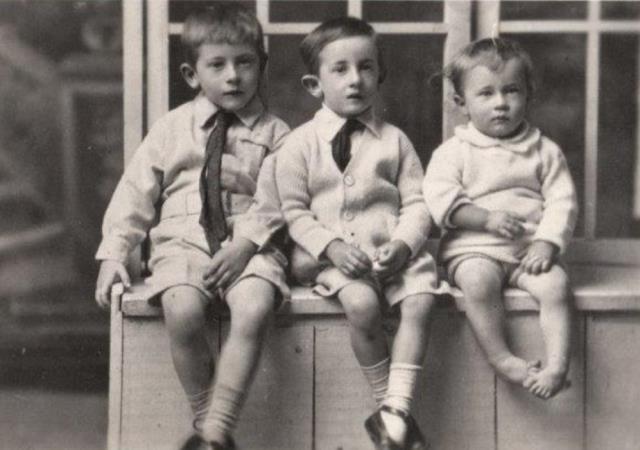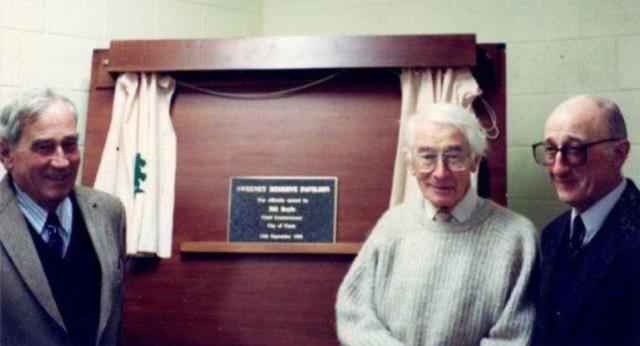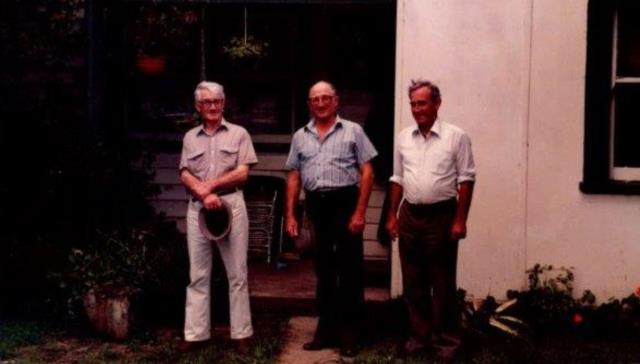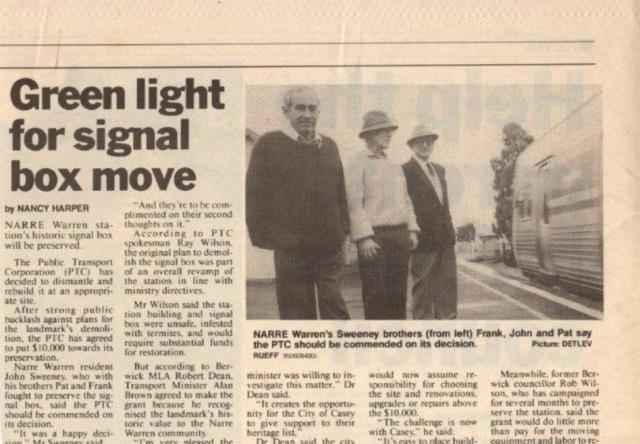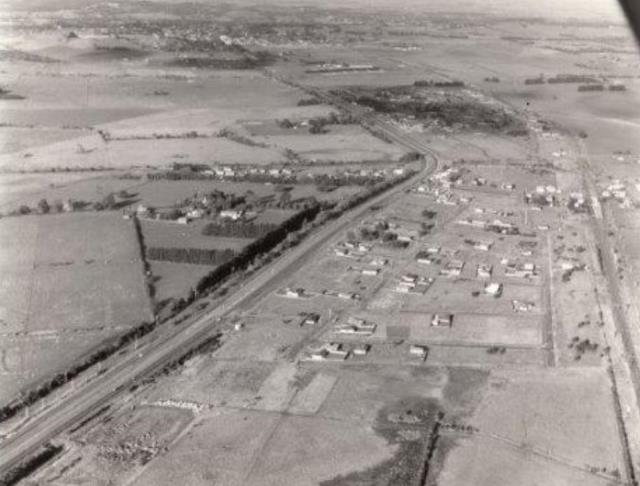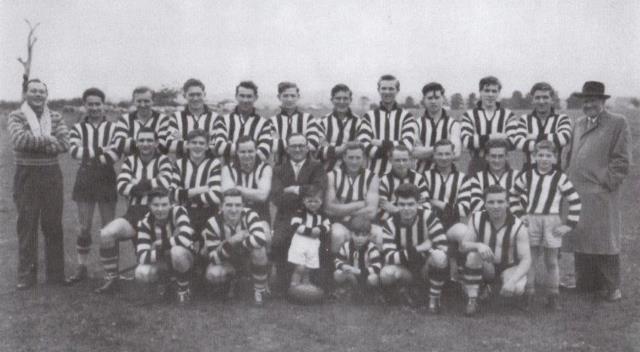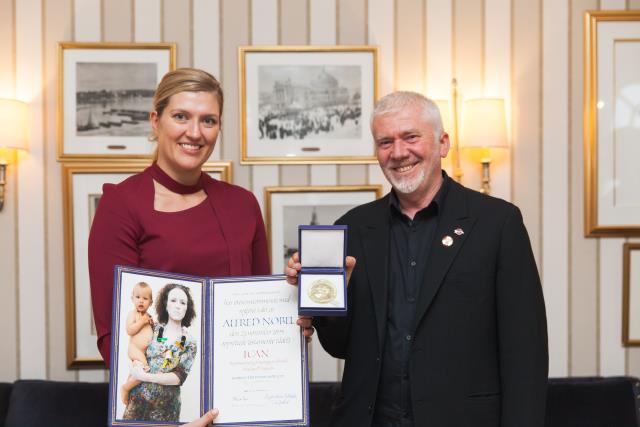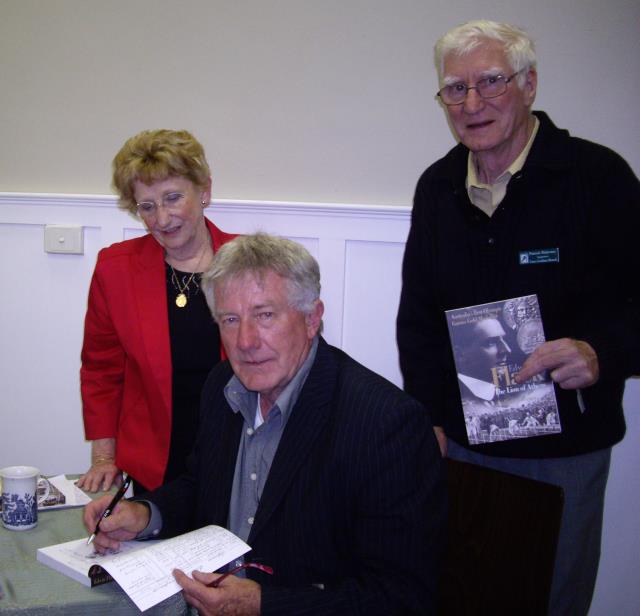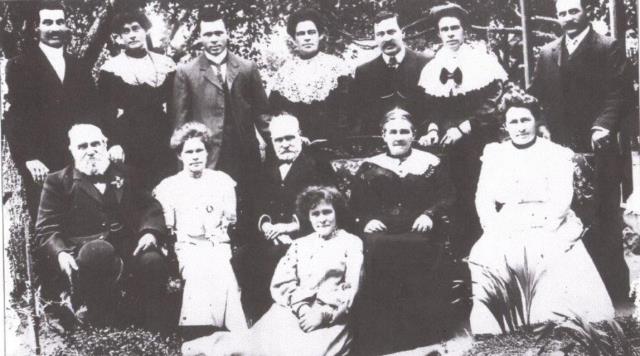
Sweeney is one of the most prominent names in the district, with descendants of Irish immigrants still dotted around the district, as NEIL LUCAS explains in his latest look at the significance of street and place names in the region.
Sweeney Drive, Narre Warren and Sweeney Reserve, Melzak Way, Berwick
There were difficult times in Ireland in the late 1840’s when a disastrous famine overtook the land – a famine which lasted for five years. The general situation in Ireland resulted in more than two million Irish citizens leaving their homeland for new beginnings overseas.
Ninteen-year-old Daniel Sweeney born in Fermoy Cork in 1831, was one of the emigrants leaving his parents Patrick and Kate and his young brother John at home in Cork.
On his arrival at Port Phillip in 1850, Daniel headed to the goldfields of Ballarat to dig for a fortune. He laboured there for more than two years seeking the elusive mineral.
Younger brother John, born in 1834, decided to join his brother in Australia and left Ireland two years after his brother.
In 1852 John boarded the sailing ship Albatross in Liverpool which was heading to Australia. The 1030 ton ship was under the command of Captain William Geves and was carrying 362 passengers.
On arrival in Melbourne John had no idea as to the whereabouts of his brother Daniel. Accordingly, he placed an advertisement in the local paper requesting his brother Daniel, who was thought to be on the goldfields of Ballarat to contact him in Melbourne. He indicated that he would remain in Melbourne for two weeks. Daniel learned of his brother John’s presence in Melbourne and the brothers were happily reunited.
The Sweeney boys chose farming rather than goldmining and travelled east from Melbourne to look for land.
They came upon a property for sale which fronted the Gippsland Road (now Princes Highway) at Narre Warren. They negotiated a purchase with a Mr Watson who was selling up and returning to England following the death of his wife and baby.
The property which they named Fermoy after their place of birth in Ireland comprised 1500 acres (607 hectares) and was located on the south side of the Gippsland Road with a western boundary along the Narre Warren/Cranbourne Road. The property was on both sides of the railway line and its southern boundary was at Centre Road.
The brothers grew crops and established a dairy herd. There was no over/underpass of the railway joining the sections on each side of the railway. The Sweeneys had gates opposite each other on each side of the railway line and herded stock across the railway when required.
The milk and cheese produced on their farm was transported by horse and cart to Melbourne.
In 1892 John took part in the competition at the local show, that year conducted at Narre Warren. His pony won second prize in the Single Buggy Pony Under 14 hands and Over 13 Hands section.
Daniel remained single throughout his life and as well as farming took a great interest in horses, riding at local race meetings held at Beaconsfield and Eumemmerring.
John met local girl Alice Reedy who had been born at sea en route to Australia. They married at Brighton in 1863.
John and Alice produced 11 children – Ellen (born 1864), Bridget (1866), Catherine (1868), Edward (1870), Michael (Mitch) (1872), Margaret (1873), William (1875), Mary (1877), Alice (1878), John (1880) and Agnes (1884).
Of the 11 children only three married – Edward, Miles and William.
John and Alice lived at Fermoy for the remainder of their lives.
Following the First World War the southern portion of their farm in the Hallam Valley along what is now Centre Road was taken over by the Government and subdivided into small farms for returned soldiers.
John died in August 1912 and was buried at the Berwick Cemetery, the cortege comprising over 30 vehicles.
John’s brother Daniel died three years later at the age of 84 years and was also buried at Berwick Cemetery.
Ellen (Nellie) Sweeney was expert in all things related to sewing and needlework. Unsurprisingly Nellie had won a prize at the local show in 1892 for her fancy woolwork.
Nellie was employed at the Narre Warren State School where she taught for six years prior to 1907. Following this, as a result of falling enrolments at Narre Warren, Nellie divided her time between Narre Warren and Narre Warren North Primary Schools for 10 years, then returned as Sewing Mistress to Narre Warren for a further four years.
Nellie died in 1938 whilst living with her sisters and brother John at Mt Carmel in Berwick.
Bridget Sweeney took up the position of Postmistress at Rupanyup in the Wimmera where she died in 1906 at the age of 40 years.
Catherine Sweeney spent most of her life on the farm at Fermoy and in later life lived with her sisters at Mt Carmel in Berwick. She died in 1936.
Mt Carmel was located on the north side of Princes Highway a little down the hill from the Peel Street intersection.
Eldest son Edward, following secondary schooling at Xavier College in Melbourne, joined the Commercial Bank where he rose to the position of manager at the Wonthaggi branch.
Edward married Mary Forest and they produced four children, Alice, John (Jack), Laurie and William (Bill). Laurie married Norma Rasmussen and they lived in Berwick producing six children – Shane, Rory, Christine, Myles, Kathy and Terry. Edward and Mary retired to Gardenvale and Edward died in 1936.
Miles (known as Mitch) Sweeney attended St Patrick’s College in East Melbourne travelling to school each day from Narre Warren by steam train.
Mitch married Catherine Murphy and they lived in Narre Warren at Stuartville, a house located on the Fermoy property and fronting the Princes Highway. Mitch worked at the farm Fermoy.
There was quite some excitement at Fermoy in January 1928. The local paper reported “A fire broke out in Mr. M. Sweeney’s paddock on Friday afternoon, immediately after a ‘down’ goods train had passed. The fire was noticed at once, and about 20 people gathered and, being helped by a strong southerly wind, were able to confine the outbreak and put it out. The same afternoon a fire sprang up in Mr. Wanke’s property, beaters turned out in force and turned the fire, and it burnt to the Narre Warren North Road, where it was conquered.”
Mitch was involved in community affairs and for some time was a member of the committee which ran the annual Narre Warren Sports Day. This event attracted a large crowd from neighbouring areas and the events conducted included a Point to Point Steeplechase, horse and pony races, foot races and novelty events such as a sack race and catching the greasy pig. Mitch and Catherine did not produce children and retired to Murrumbeena.
Following Catherine’s death, Mitch acquired Mt Carmel at Berwick, where he lived with a number of his sisters – he died in 1950.
Margaret took up nursing and worked at the St Vincent’s Hospital in Melbourne. She died in 1958.
William was also educated at Xavier College where he was appointed School Captain in 1894. He married Ellen O’Keefe in 1920 and they initially lived at Florence Court Benalla where their three sons John (born 1921), Pat (1923) and Frank (1925) were born.
In 1936 William acquired a 240 acre (97 hectares) property on the north side of the Princes Highway at Narre Warren, across the road from the family property Fermoy. The vendor was Anthony Kent who farmed the land named Oatlands to the north. Kent had lived in the house on William Sweeney’s new property while his new homestead had been under construction.
William Sweeney named his new property Florence Ville, a variation of his former home in Benalla Florence Court. The land had its western boundary at Narre Warren North Road and its eastern boundary at Hessell Road (the southern end of Hessell Road is along the north /south alignment of Grant Close, Berwick).
At a later time William purchased another farm at Toora but remained living at Narre Warren.
William died in 1944. A eulogy described him as a leading grazier and cattleman throughout his active life and commented that he had earned the liking and respect of all who knew him. Straightforward and honest in all his business dealings, he stood high in public esteem.
Mary was a school teacher who worked for the Victorian Education Department at Cranbourne and in Abbotsford. Mary did not marry and after retiring lived with her sisters at Mt Carmel in Berwick until her death in 1936.
Sadly, Alice Sweeney had a short life, dying at the age of 13 years.
John Sweeney, although a capable student, left school at an early age to take up farming. John was a keen and capable sportsman and was recorded in March 1899 as taking 3 wickets for 15 runs for the Narre Warren Railways team in a game against the visiting Fitzroy Trades team. John later batted hitting up 66 runs including one six.
John did not marry and following his brother Mitch’s retirement he took over sole management of Fermoy.
An unusual event occurred at Fermoy in August 1932. The pilot of a Tiger Moth aeroplane travelling from Sale to Melbourne in the late afternoon decided it was just too dark to continue so chose to land in one of John Sweeney’s paddocks. Like Mitch, John also retired to live with his sisters at Mt Carmel. He died in 1941.
In April 1893 Agnes, at the age of 9, won the Under 12 Girls race at the Narre Warren Sports Day. She then watched her brother John win the Boys Under 12 race.
Agnes loved farming and animals and spent most of her life doing just that at Fermoy. Following her retirement Agnes lived with her sister Margaret at Mt Carmel.
An article in 1926 provided a description of the Fermoy farm under the heading – “ AYRSHIRES AT NARRE WARREN
“As a good all-round cow the Ayrshire has many strong advocates throughout Victoria. Prominent among these are men engaged in the production of fresh milk for city consumption. The famous Scottish cattle are hardy, and mature quickly. Another feature claimed for them is that they are “good doers,“ and give satisfactory results on a minimum of food. A typical herd of the breed is that found on the property of Messrs. Sweeney Bros., who are among the largest and most successful dairymen around Narre Warren. After many years’ experience, they are convinced that this is the most suitable dairy cow for the district, though they also have a good opinion of the Jersey.
“Messrs. Sweeney succeeded their father on this property, which was acquired by the latter over 60 years ago. It consists of rising land and flats. The original area was 1500 acres, but 700 acres of the low-lying land, which was subject to floods, has been sold to the State Rivers and Water Commission in connection with the reclamation and closer settlement scheme now in hand in that locality. Those flats have been cleared of ti-tree, and should be very suitable for market gardening and other branches of intensive culture, for which they are to be used. Messrs. Sweeney Bros.’ farm is on both sides of the North Gippsland line. It is well sheltered and carries good feed, including subterranean clover. Three bores on which windmills have been erected give an abundance of water. On the flats it is possible to strike a supply at from 12 to 20ft.
“Among the pure Ayrshire bulls used in the past have been those of well-known breeders, such as Messrs. Grant, Gibbs, Kirkham and Bamford. The herd numbers 60, apart from 25 calves and 20 two-year-old heifers. Messrs. Sweeney state that their cows average 10 quarts of milk daily for a fair period, and are given a spell for two months each year.
“The milk is sent to Melbourne by motor lorry. Though this form of transport is more costly than the railways, it offers many advantages. The milk is picked up at the gate, which saves a journey to the station, and perhaps a long wait for the train. At present supplies are taken only once a day. The milking sheds, with brick floors, are situated on a rise, which permits of good drainage and general cleanliness. The bails number 44, in two rows.
“Years ago hay production was an important branch of the operations on this property, and from 200 acres £6000 worth of hay has been sold.”
The next generation of Sweeneys was relatively small compared with the potential that had existed from John and Alice’s 11 children. Of the eleven, only three boys had married, and between them there were seven children.
Edward and Mary’s children did not farm in Narre Warren, but William and Ellen’s sons John, Pat and Frank worked at Fermoy and their father’s Florence Ville property, and also the farm at Toora for the majority of their working lives during which time they were leading figures in the Narre Warren community.
John Sweeney, following his education at Xavier College, took up farming as his calling. He married Shelagh Carroll in 1952 in his old school’s chapel and he and Shelagh produced five children – Peter, Michael, Mark, Jane and David.
John followed his “apprenticeship” in farming at Fermoy and Florence Ville with the management of the Talbingo farm located on Narre Warren South Road to the southside of the railway.
Pat was also educated at Xavier College and took up farming. He married Lucy Everitt in 1945 and produced five children – William, Colleen, Barbara, Susan and Claire. Pat remained farming at Florence Ville until his retirement when the farm was sold for development in the 1980s.
John and Pat’s brother Frank served in the Army seeing action in New Guinea and Borneo during World War II.
Prior to the war Frank worked in the administration at the Newmarket Stockyards. Frank came to Narre Warren after the war and farmed on part of his grandfather’s former Fermoy property.
Frank married Mary Maher in 1954 and they produced six children – Andrew, Nicholas, Kathryn, John, Elizabeth and Mary Louise. Frank’s son Andrew farmed at Fermoy until 1984.
The Sweeney brothers were great contributors to the Narre Warren community. All were founding members of the Narre Warren Fire Brigade and the Narre/Hallam Football Club.
Pat was a keen and courageous footballer described in the local press as inimitable. In the 1953 match between Narre Warren which Pat captained, and Berwick, the clash between Pat and the Berwick captain Mick Carrol was described as one of the features of the game.
As well as playing, Pat was appointed as the club’s first president, a position he held for a total of five seasons. Pat later became the president of the South West Football League.
In 1953 Pat was elected as the inaugural president of the newly formed Narre Warren Progress Association and for 25 years was a member of the Pakenham Racing Club’s committee.
In 1954 the Sweeney family made an offer of seven acres (2.6 hectares) of land at an extremely reasonable price to the local community for the purposes of constructing a football/cricket oval and netball courts – the land was located at the north-east corner of the Princes Highway and wrapped around a 1.5 acre (0.5 hectare) allotment where the war memorial and a tennis court had been constructed in 1923. The Narre Warren Progress Association raised the funds and a grassed oval was constructed.
In the 1970s the Sweeney family made another significant gift, this time to the Roman Catholic Church. The donation was a parcel of land on the north side of the Princes Highway for the purposes of a church and primary school. Subsequently the Our Lady Help of Christians Catholic Church and Don Bosco School were established on the site.
From the earliest times, the Sweeney family were associated with St Michael’s Church at Berwick where they regularly worshipped and supported in every way. The local paper described a fundraiser held at Narre Warren in January 1930 – “‘A successful dance was held at the Narre Warren Hall on Monday, 20th inst., in aid of the Queen fund of the Roman Catholic Church. Mr. Chas. Saunders acted as honorary secretary, and was ably assisted by Messrs. M.Sweeney and Grogan. Mesdames Willett, M. Sweeney, Bahnan and Miss A. Sweeney, with others, supervised the supper, when there was provided a dainty repast. All present enjoyed the evening, funds will receive a nice fillip.”
The Sweeney family have been associated with the Berwick Cemetery for more than 100 years volunteering as Trust Members. All but a few of the first and second generations in this district were buried at the cemetery.
Many of the later generations of Sweeneys still live in the district and in turn continue to make their mark on the community.
Of particular note is Dave Sweeney (John and Shelagh’s son) who was co-founder of ICAN, an organisation which promotes adherence to and implementation of the United Nations Treaty on the Prohibition of Nuclear Weapons. ICAN was awarded the 2017 Nobel Peace Prize.
Another interesting highlight, amongst many, was the contribution made to local history by Dave’s brother Peter a journalist, who in 2004 produced a book Edwin Flack – The Lion of Athens.
Flack farmed at Berwick following his successes in the first Modern Olympics.

